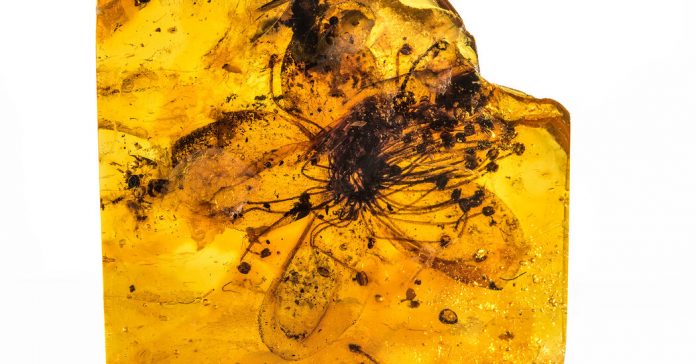Eva-Maria Sadowski, a postdoctoral researcher on the Pure Historical past Museum in Berlin, didn’t have a selected agenda in thoughts when she determined to borrow the largest fossil flower preserved in amber ever discovered.
“I did it with none expectations, I simply did it as a result of I used to be curious,” she mentioned.
Her curiosity pulled the thread of a greater than 150-year-long case of mistaken id, leading to a clearer image of what the Baltic amber forest of Northern Europe seemed like greater than 33 million years in the past.
The preserved flower bloomed about midway between the extinction of the final non-bird dinosaurs and the evolution of people, who discovered it within the nineteenth century in territory that’s now a part of Russia. In 1872, scientists categorized it as Stewartia kowalewskii, an extinct flowering evergreen.
The Baltic amber flower’s id hadn’t been revised till Dr. Sadowski’s paper in Scientific Experiences was printed Thursday.
Vegetation in amber are a rarity. Amongst Baltic amber specimens, only one % to three % of trapped organisms are botanical. This may end result from a bias towards animals by amber collectors, however it additionally could be as a result of animals wander into swimming pools of sticky resin whereas crops should unintentionally fall in.
Whereas they’re tougher to come back by, crops in amber present paleobotanists with a wealth of data, Dr. Sadowski mentioned. Amber, which varieties from tree resin, preserves historical specimens in three dimensions, revealing “all the fragile options that you simply usually don’t get in different fossil sorts.”
The flower that caught Dr. Sadowski’s eye was an inch broad — thrice larger than the next-largest blossom preserved in amber ever found. A colleague had advised her of the flower’s “large” measurement earlier than she sought it out, and she or he puzzled if he was exaggerating. He wasn’t. She then determined to see what 150 years of technological advances may be capable of reveal about Stewartia kowalewskii.
As soon as she had the fossil flower in hand, Dr. Sadowski polished the amber block with a humid leather-based fabric and toothpaste — a way she picked up from her doctoral adviser, Alexander Schmidt, who discovered a few of his strategies from a dentist. Beneath a robust microscope, Dr. Sadowski noticed completely preserved particulars of the flower’s anatomy, together with specks of pollen, which she used the pollen to see if the plant had been sorted into the proper household 150 years in the past.
Dr. Sadowski scraped grains from close to the amber’s floor with a scalpel. “I solely try this on a really quiet morning in my workplace, the place nobody disturbs me — you want regular fingers, no shaking,” she mentioned.
After isolating and imaging the grains, her co-author on the examine, Christa-Charlotte Hofmann on the College of Vienna, investigated the pollen, together with microscopic options of the flower’s anatomy. That pointed to a wholly completely different genus group than had been assigned in 1872: Symplocos, a genus of flowering shrubs and small timber not present in Europe at present however widespread in trendy East Asia.
The redesignation of the large flower helps to flesh out what scientists know concerning the ecological variety of the Baltic amber forest. It additionally sheds gentle on how Earth’s local weather has modified during the last 35 million-odd years: The presence of Symplocos helps to point out that historical Europe was balmier than it has been for many of human historical past.
“These tiny grains are pure recorders of previous climates and ecosystems that may assist us measure how a lot our planet has modified prior to now as a consequence of pure (nonhuman) causes,” mentioned Regan Dunn, a paleobotanist at La Brea Tar Pits and Museum who was not concerned with the analysis. “This permits us to raised perceive simply how a lot our species is impacting the planet.”
Whereas “Jurassic Park” fanatics could also be upset to study that there’s no probability of getting DNA from the amber flower, George Poinar Jr., a scientist whose work impressed the sequence, mentioned that there are certain to be extra breakthroughs. Within the almost 50 years he’s been finding out amber, advances in microscopy have made once-hidden particulars of historical organisms dramatic and clear.
“I believe that’s fascinating, for individuals to see life like that,” he mentioned.


